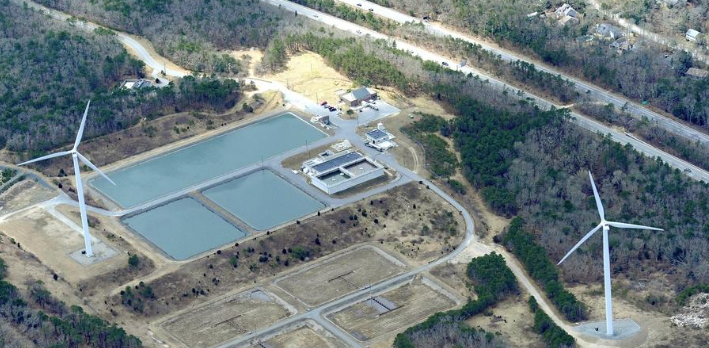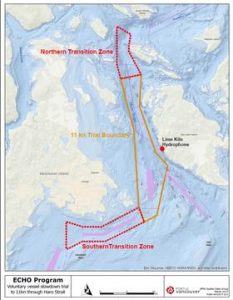The Falmouth Board of Selectmen have decided not to continue the legal battle over two wind turbines that began operation at the town’s wastewater treatment facility in 2010 and 2012. The decision comes in the wake of a ruling from Massachusetts Superior Court last week that called for immediate cessation of turbine operations. Wind 1 has been shut off since 2015 by a previous court ruling, and Wind 2 has been operating only during the day after being found to exceed the background ambient noise at night by more than is allowed.� The turbines have been challenged on several legal fronts, including the initial permitting, nuisance, and decreased property values. The town will now grapple with the costs of dismantling and paying off loans taken to erect the turbines; most of the financial obligations are to state-funded clean energy programs, and there is hope that some or most will be forgiven, though nothing is certain on that front.

In the recent case that apparently broke the camel’s back for the Selectmen, the judge affirmed a 2013 Zoning Board of Appeals nuisance ruling that called for the Building Commissioner to “take whatever steps necessary to eliminate the nuisance” at the property of Barry and Diane Funfar. The town appealed that ruling (legally challenging its own Zoning Board of Appeals), and this case was addressing that appeal. Several other cases remain in the pipeline, but the Selectmen’s decision should lead to an end to the legal battles. While the judge in this case affirmed the nuisance experienced by the Funfars, he rejected the property value claim, noting that the most reliable data, from sales in 2012 and 2013, show a 3% decline in value in the Funfar’s neighborhood, not enough to point to the turbines as a deciding factor.
Mr. Funfar, who used to spend much of his time creating extensive gardens in his yard, had found himself unable to be outside, and eventually, even to stay in the house. The Funfars had begun spending time in the Dominican Republic to escape the noise impacts. “It’s rather euphoric,” he said after the ruling was announced. “We had a very good life here in our retirement, and I had my grandkids up here all the time helping me in my yard, and we can get some of that back now….It’s just such a tremendous relief to me and it’s still taken these past couple of days to sink in.”
Susan Moran, chair of the Board of Selectmen, noted that “As a board, despite all our personal differences and philosophies, we feel we have done all we can do to honor the town meeting ballot votes in 2013 as well as the 2015 nonbinding vote for the town to continue to operate the two turbines.” Appealing this decision and continuing to fight the other challenges would leave the town “right where we have been for the last seven years — with uncertainly and mounting legal expenses,” Moran said.
Christina C. Rawley, a member of the Falmouth Climate Action Team, which had fought to keep the turbines operating, said, “It’s very upsetting and extremely disappointing. We’re all sort of [taken aback] by it and trying to decide now what is the best way forward.” At the same time, Rawley stressed that “We are not coldhearted people by any means….and it was never anybody’s intent to harm anyone. How does a town or a nation make [its] decisions is what is at question here. How can we possibly meet the problems that are outstanding in our society?”
Since the very beginning of all this, the Falmouth situation has been a good example of the pitfalls of siting turbines close to densely populated neighborhoods. Few wind turbines have so many homes so close; at least 184 homes within a half mile of just these two turbines (a third turbine, privately owned, continues to operate; the legal challenges have been primarily directed at the town-run turbines). With so many homes so close, it was inevitable that a critical mass of impacted neighbors would arise.
In 2012, the town spent several months on a collaborative Wind Turbines Options Process that brought together town officials, impacted neighbors, and renewable energy advocates to explore whether the town could find ways to address or compensate those struggling with the noise. The possibility of the town buying some of the homes that had been most affected was on the table. At that time, about 10% of those within a half mile had lodged formal complaints (7 out of 18 homes within a quarter mile, and 12 of 166 from a quarter to half mile). Likewise, in 2010, amidst the initial outcry about unexpected noise levels after the first turbine went live, the town sent log sheets to 300 homes, for residents to note the times when noise was an issue for them; about a dozen were returned, or under 5%. We can presume that more people were bothered than participated in these initiatives, but it remains the case that it’s generally a relatively small percentage of the population that is especially sensitive to noise impacts.
This is one reason that towns have taken a wide range of approaches to wind turbine siting, ranging from minimal setbacks of as little as 500-1000 feet (in areas that don’t mind that their residents will regularly hear the turbines), to moderate setbacks of 1200-2000 feet (accepting that some residents will experience troublesome noise at times), to precautionary setbacks of 4000 feet or more, which hope to avoid causing noise intrusions for even the more sensitive members of the community. All of these approaches can be justified; the question is how any given town chooses to balance economic benefit (often high in farm and ranch communities), climate-change mitigation (minimal for any given project, but necessary collectively), changes to sense of place (also a factor in many rural communities), and impacts on the most noise-sensitive or otherwise susceptible members of their community.
The reality of life-changing impacts on a relatively small proportion of those hearing turbines is an especially fraught element in the debate; many infrastructure projects or industrial developments cause similar rates of disruption among their nearby neighbors. Courts and local governments have come down on different sides of this sensitive question, and it is here where towns will continue to face the most difficult and distressing decisions.
 South Dakota has the nation’s 4th-best wind resources, and wind is currently the source of 30% of the energy produced in the state, the 2nd highest proportion the nation—yet it lags behind several of its great plains brethren in ramping up its wind industry, which currently has about 1000MW of installed capacity. North Dakota is home to nearly three times as much wind energy, while Iowa and Oklahoma each host nearly seven times as much. But if recent push-back is an indication of things to come, the wind boom that many SD farmers hope for may not materialize unless they adopt a more collaborative approach to working with their neighbors.
South Dakota has the nation’s 4th-best wind resources, and wind is currently the source of 30% of the energy produced in the state, the 2nd highest proportion the nation—yet it lags behind several of its great plains brethren in ramping up its wind industry, which currently has about 1000MW of installed capacity. North Dakota is home to nearly three times as much wind energy, while Iowa and Oklahoma each host nearly seven times as much. But if recent push-back is an indication of things to come, the wind boom that many SD farmers hope for may not materialize unless they adopt a more collaborative approach to working with their neighbors.
 A nine-year court battle over motorized recreation in Utah’s red rock country has ended with
A nine-year court battle over motorized recreation in Utah’s red rock country has ended with  On the other side of the table, Paul Turcke, the attorney for off-highway vehicle groups, said, “We’re not turning cartwheels over this, but given the alternatives and given the fact that we could participate effectively and make positive changes to this agreement, we think it’s the best option for moving forward.” Motorized recreation enthusiasts applauded the lack of any immediate changes on the ground; no routes were closed as part of the settlement, though some are likely to be shut down during the renewed planning process. Turke notes, “Everyone gets a fair shake in the future process and they can challenge the outcome if they choose.”
On the other side of the table, Paul Turcke, the attorney for off-highway vehicle groups, said, “We’re not turning cartwheels over this, but given the alternatives and given the fact that we could participate effectively and make positive changes to this agreement, we think it’s the best option for moving forward.” Motorized recreation enthusiasts applauded the lack of any immediate changes on the ground; no routes were closed as part of the settlement, though some are likely to be shut down during the renewed planning process. Turke notes, “Everyone gets a fair shake in the future process and they can challenge the outcome if they choose.” Haro Strait is a narrow passageway between Canada’s Vancouver Island the American San Juan Island, and is a prime summer feeding ground for the resident orca population, which has dwindled to less than 80 members. The voluntary speed restrictions will ask all ships to slow to 11 knots (about 13 mph) through a 16-mile corridor; cruise ships and container ships often run at 18-20 knots, while bulk carriers travel at 13-15 knots. The slowdown will reduce the noise of each ship as it passes by 40% or more, though it will linger in the area a bit longer; the net effect is expected to be beneficial by reducing the degree of impact on animals in the region.
Haro Strait is a narrow passageway between Canada’s Vancouver Island the American San Juan Island, and is a prime summer feeding ground for the resident orca population, which has dwindled to less than 80 members. The voluntary speed restrictions will ask all ships to slow to 11 knots (about 13 mph) through a 16-mile corridor; cruise ships and container ships often run at 18-20 knots, while bulk carriers travel at 13-15 knots. The slowdown will reduce the noise of each ship as it passes by 40% or more, though it will linger in the area a bit longer; the net effect is expected to be beneficial by reducing the degree of impact on animals in the region.